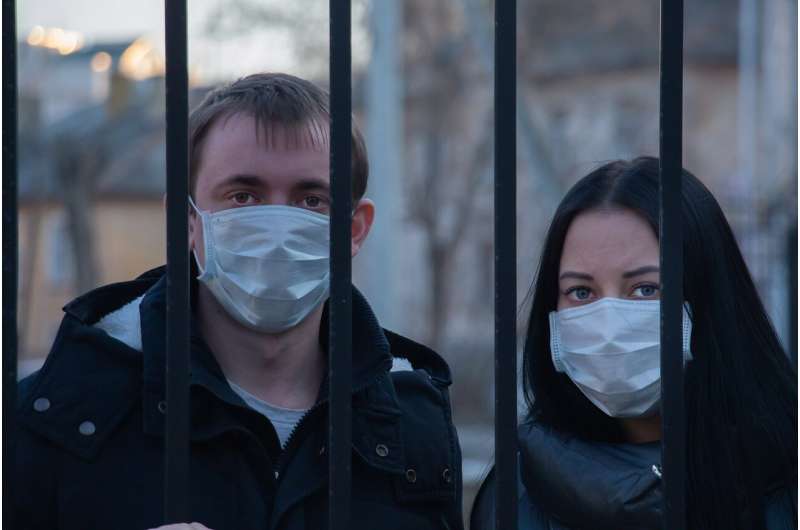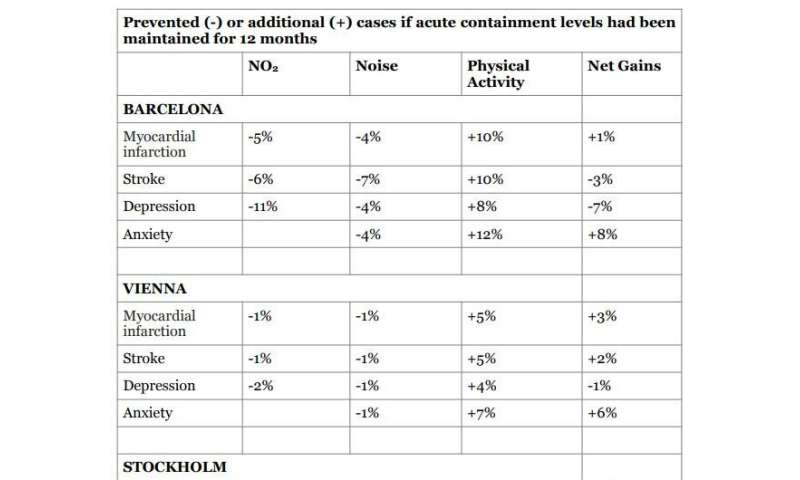
The lockdown measures imposed in March 2020 to contain the COVID-19 pandemic led to unprecedented declines in air pollution, noise and physical activity levels in cities. The consequences of these changes for people’s health differed depending on the stringency of the confinement measures and local context, giving insights into how emergency measures can more broadly affect population health. What lessons can be learned for future urban planning policies and emergency preparedness? A study published in Environmental Pollution led by the Barcelona Institute for Global Health (ISGlobal), a center supported by the “la Caixa” Foundation, has attempted to answer these questions.
To compare different contexts, the research team selected three European cities with different degrees of confinement measures: Barcelona, where a strict lockdown was imposed including law-enforced home confinement; Stockholm, where the measures were much more relaxed and ultimately subject to individual responsibility and “common sense”; and, finally, Vienna, which had intermediate measures.
For each of the three cities, they collected or estimated data on air pollution, noise and physical activity from three different points in time: before the pandemic, during the acute confinement and in the subsequent deconfinement period. In a first step, the researchers calculated the differences in these environmental exposures and health behaviors between pre-pandemic and pandemic levels. In a second step, those differences were compared with existing health data and translated into how many annual diagnoses of heart attacks, strokes, depression, and anxiety could have been prevented or would have been caused in addition in every city if the changes in air pollution, noise, physical activity and greenspace visits had been extended for one year.
Decreases in physical activity levels of up to 95%
The first findings of the study showed that the strictness of the confinement measures was directly related to the decline in exposures and behaviors studied. Thus, the city with the toughest confinement, Barcelona, was also the one that recorded the largest decreases with respect to the pre-pandemic levels of air and noise pollution, physical activity, and greenspace visits. Specifically, during the first lockdown, nitrogen dioxide (NO2) concentrations fell by 50% on average, daily noise levels were reduced by 5 decibels (dB A) and physical activity was reduced by 95%.
During the same period, in Vienna, NO2 pollution fell by 22%, average daily noise levels were reduced by 1 dB(A), while physical activity was decreased by 76%.
For Stockholm, NO2 levels fell by 9%, daily noise levels were reduced by 2 dB(A) and physical activity fell by 42%.
Physical activity as a health determinant
Having quantified the changes in each city compared to the pre-pandemic levels, the team calculated the impact of each of these changes on health. To do this, they drew on evidence from previous studies that established relationships among each of the exposures and behaviors studied and various cardiovascular diseases and mental disorders. Finally, to reflect the true magnitude of the changes studied in the long-term, a data model was used to simulate the impact that the containment measures would have had if extended over a full year.
From all the factors included in the study, physical activity was the main driver of health outcomes. Thus, a hypothetical extension of strict confinement in Barcelona for a full year would have resulted in a 10% increase in strokes and heart attacks and an 8% and 12% increase in diagnoses of depression and anxiety, respectively, due to the reductions in physical activity.
Reduction of physical activity in Vienna for a whole year, in turn, could have led to a 5% increase in the annual incidence of strokes and heart attacks, as well as 4% and 7% increase in diagnoses of depression and anxiety, respectively.
Even in Stockholm, the city with the slightest decline in physical activity levels, there would have been negative health effects if the situation had lasted for a year. The model estimated a 3% increase in the respective incidences of strokes and heart attacks, 2% additional diagnoses of depression and 3% additional cases of anxiety.
Pollution and noise on the positive side
The decreases in air and noise pollution data brought positive effects. If the reduction in NO2 concentrations from the first lockdown had been sustained for a whole year, an estimated 5% of heart attacks, 6% of strokes and 11% of depression diagnoses could have been prevented in the city of Barcelona. In Vienna, the estimated decreases would be 1% for strokes and heart attacks and 2% for depression. In Stockholm the positive health impact would be the prevention of 1% of depression diagnoses.
In the long-term, improved noise levels in Barcelona could have prevented an estimated 4% of annual heart attacks, 7% of strokes and 4% of diagnosed depression. In Vienna, the incidence of myocardial infarction, stroke and depression could have been reduced by 1%. And finally, for Stockholm, a 2% reduction in diagnosed heart attacks and depression, and a 4% reduction in stroke cases related to noise reductions is estimated.
Negative balance
“Despite the differences observed in the three cities, there is a common pattern: the health benefits of improved air quality and noise fail to offset the profoundly negative effects of reduced physical activity levels,” summarizes Sarah Koch, ISGlobal researcher and first author of the study.
“In terms of urban health, the confinements and subsequent deconfinements gave us the opportunity to generate valuable evidence and understand how emergency strategies like lockdowns can have broader health impacts for the population. The results of our study show the benefits that could be obtained by implementing urban planning policies that significantly reduce air pollution and noise while encouraging physical activity and contact with green spaces”, concludes Mark Nieuwenhuijsen, director of ISGlobal’s Air Pollution and Built Environment program and last author of the study.

Methodology
Source: Read Full Article
